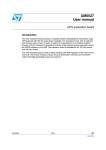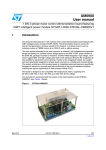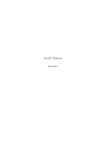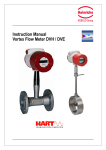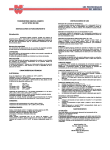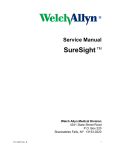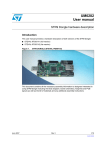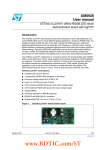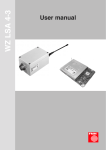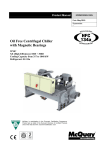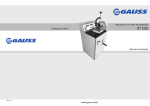Download STEVAL-ILL022V1 solar-LED streetlight controller with 25
Transcript
UM0512 User manual STEVAL-ILL022V1 solar-LED streetlight controller with 25 W LED lamp driver and 80 W battery charger based on the STM32F101Rx Introduction The solar-LED streetlight controller consists of one 80 W battery charger and one 25 W LED driver. During the daytime, when there is sufficient sunlight, the charger converts the electricity from the solar panel and charges the battery. At nighttime, the battery powers on the LED lamp as streetlight. If it is rainy or cloudy for several continuous days, the battery will gradually run out of power. The controller then resorts to the AC mains supply to power on the LED until the battery has had time to fully charge again. Main features of the solar-LED streetlight controller ■ Maximization of electricity conversion efficiency from solar panel by way of maximum power point tracker (MPPT) ■ Automatic day/night/weather detection ■ Automatic battery/mains switch over ■ Constant current control for LED lamp ■ Battery charge control ■ Optional LED lighting duration mode ■ Easy system monitoring via debug LED indicators ■ Full protection function for OTP, OCP and UVP Figure 1. Snapshot of the solar-LED streetlight controller !-V September 2010 Doc ID 14469 Rev 2 1/18 www.st.com Contents UM0512 Contents 1 Safety instructions . . . . . . . . . . . . . . . . . . . . . . . . . . . . . . . . . . . . . . . . . . 4 1.1 Intended use . . . . . . . . . . . . . . . . . . . . . . . . . . . . . . . . . . . . . . . . . . . . . . . 4 1.2 Installation . . . . . . . . . . . . . . . . . . . . . . . . . . . . . . . . . . . . . . . . . . . . . . . . . 4 1.3 Electrical connection . . . . . . . . . . . . . . . . . . . . . . . . . . . . . . . . . . . . . . . . . 4 1.4 Board operation . . . . . . . . . . . . . . . . . . . . . . . . . . . . . . . . . . . . . . . . . . . . . 4 2 General description . . . . . . . . . . . . . . . . . . . . . . . . . . . . . . . . . . . . . . . . . . 5 3 Hardware description . . . . . . . . . . . . . . . . . . . . . . . . . . . . . . . . . . . . . . . . 6 4 3.1 Board description . . . . . . . . . . . . . . . . . . . . . . . . . . . . . . . . . . . . . . . . . . . . 6 3.2 Controller characteristics . . . . . . . . . . . . . . . . . . . . . . . . . . . . . . . . . . . . . . 7 Operating instructions . . . . . . . . . . . . . . . . . . . . . . . . . . . . . . . . . . . . . . . 8 4.1 Hardware installation . . . . . . . . . . . . . . . . . . . . . . . . . . . . . . . . . . . . . . . . . 8 4.2 Recommended peripheral parameters . . . . . . . . . . . . . . . . . . . . . . . . . . . . 8 4.3 5 4.2.1 Solar panel . . . . . . . . . . . . . . . . . . . . . . . . . . . . . . . . . . . . . . . . . . . . . . . . 8 4.2.2 Battery . . . . . . . . . . . . . . . . . . . . . . . . . . . . . . . . . . . . . . . . . . . . . . . . . . . 8 4.2.3 LED . . . . . . . . . . . . . . . . . . . . . . . . . . . . . . . . . . . . . . . . . . . . . . . . . . . . . 8 4.2.4 Mains switch . . . . . . . . . . . . . . . . . . . . . . . . . . . . . . . . . . . . . . . . . . . . . . 9 Troubleshooting . . . . . . . . . . . . . . . . . . . . . . . . . . . . . . . . . . . . . . . . . . . . . 9 DIP selection and LED indicator . . . . . . . . . . . . . . . . . . . . . . . . . . . . . . 10 5.1 DIP selection switch . . . . . . . . . . . . . . . . . . . . . . . . . . . . . . . . . . . . . . . . . 10 5.2 LED indicator . . . . . . . . . . . . . . . . . . . . . . . . . . . . . . . . . . . . . . . . . . . . . . 10 6 Schematic and bill of materials . . . . . . . . . . . . . . . . . . . . . . . . . . . . . . . 12 7 Revision history . . . . . . . . . . . . . . . . . . . . . . . . . . . . . . . . . . . . . . . . . . . 17 2/18 Doc ID 14469 Rev 2 UM0512 List of tables List of tables Table 1. Table 2. Table 3. Table 4. Table 5. Table 6. Table 7. Table 8. Table 9. Table 10. Description of functions . . . . . . . . . . . . . . . . . . . . . . . . . . . . . . . . . . . . . . . . . . . . . . . . . . . . 6 Recommended electrical parameters for solar panel . . . . . . . . . . . . . . . . . . . . . . . . . . . . . . 8 Recommended electrical parameters for battery . . . . . . . . . . . . . . . . . . . . . . . . . . . . . . . . . 8 Recommended electrical parameters for LED . . . . . . . . . . . . . . . . . . . . . . . . . . . . . . . . . . . 8 Symptoms and corrective action. . . . . . . . . . . . . . . . . . . . . . . . . . . . . . . . . . . . . . . . . . . . . . 9 DIP switch for LED lamp light-on time selection . . . . . . . . . . . . . . . . . . . . . . . . . . . . . . . . . 10 LED indicator and error message . . . . . . . . . . . . . . . . . . . . . . . . . . . . . . . . . . . . . . . . . . . . 10 BOM . . . . . . . . . . . . . . . . . . . . . . . . . . . . . . . . . . . . . . . . . . . . . . . . . . . . . . . . . . . . . . . . . . 13 Pin strip header. . . . . . . . . . . . . . . . . . . . . . . . . . . . . . . . . . . . . . . . . . . . . . . . . . . . . . . . . . 16 Document revision history . . . . . . . . . . . . . . . . . . . . . . . . . . . . . . . . . . . . . . . . . . . . . . . . . 17 Doc ID 14469 Rev 2 3/18 Safety instructions 1 Safety instructions Warning: 1.1 UM0512 The demonstration board must be used in a suitable laboratory by qualified personnel only, familiar with the installation, use and maintenance of electrical systems. Intended use The demonstration board is a component designed for demonstration purposes only, and shall not be used for domestic or industrial installations. The technical data and information concerning the power supply and working conditions must be taken from the documentation provided with the delivery, and must be strictly observed. 1.2 Installation The installation instructions of the demonstration board must be taken from the present document and strictly observed. The components must be protected against excessive strain. In particular, no components are to be bent, or isolating distances altered, during the transportation, handling or use. The demonstration board contains electro-statically sensitive components that are prone to damage through improper use. Electrical components must not be mechanically damaged or destroyed (to avoid potential risks and health injury). 1.3 Electrical connection Applicable national accident prevention rules must be followed when working on the mains power supply. The electrical installation must be completed in accordance with the appropriate requirements (e.g. cross-sectional areas of conductors, fusing and PE connections). 1.4 Board operation A system architecture that supplies power to the demonstration board must be equipped with additional control and protective devices in accordance with the applicable safety requirements (e.g. compliance with technical equipment and accident prevention rules). 4/18 Doc ID 14469 Rev 2 UM0512 2 General description General description The solar-LED streetlight controller is the key element of the system, also comprising the solar panel, battery and LED streetlight (lamp). Figure 2 shows the structure of the system. Figure 2. System block diagram !-V Each block’s function is described below. ● The sunlight delivers pockets of photons (solar energy) to the solar panel (also called photovoltaic or PV module). The photons (energy) are absorbed by the PV module and electrons are released. ● The electrons flow along the metal contact of the PV module and create electricity. The battery charger then converts the electrical energy and charges the battery. ● The battery stores the electricity supplied by the battery charger. The controller monitors the status of the battery. ● The LED lamp (LED streetlight) is activated by the LED driver. The LED light controller monitors the system and controls the light-on and light-off in daytime and nighttime. ● When the battery goes low, the controller sends an enable signal to the mains switch and the AC offline power supply is enabled. The AC offline power supply (not covered in this document) acts as a backup source to power the LED streetlight. The solar-LED streetlight controller plays the key role in the system for electricity (solar energy) storage control and LED lamp light-on/-off control. Doc ID 14469 Rev 2 5/18 Hardware description UM0512 3 Hardware description 3.1 Board description Table 1 describes the various functions of the controller’s demonstration board. Figure 3 provides the top view of the board. Table 1. Category System connectors HMI Description of functions Index Designator 1 P1 2 P4 Battery temperature sensor connector (connected to NTC) 3 P5 LED lamp temperature sensor connector (connected to NTC) 7 P6 Mains enable output 10 P3 LED lamp connector 11 P2 Battery connector 4 SW1~SW4 5 LED1~LED4 6 Description Solar panel connector DIP switch (1): mode selection Debug indicators(2) LED 5 (red) ON: battery charged OFF: battery not charged LED5, LED6 LED 6 (white) ON: battery full OFF: battery not full ICP interface 9 PB1 Reset 8 CN1 JTAG 1. Refer to Table 6 for dip selection mapping. 2. Refer to Table 7 for debug message mapping. 6/18 Doc ID 14469 Rev 2 UM0512 Hardware description Figure 3. Top view of demonstration board !-V 3.2 Controller characteristics The controller has the following characteristics. ● Battery operation voltage: – ● ● ● 13.8 V max./11 V min. for 12 V system Charger: – input voltage range ≤ 50 VDC – output power ≤ 80 W LED lamp driver: – output current 2.45 A – output power ≤ 25 W Dimensions: – 113 mm x 98 mm x 50 mm Doc ID 14469 Rev 2 7/18 Operating instructions UM0512 4 Operating instructions 4.1 Hardware installation The following steps are to install the hardware. 1. Connect an NTC resistor (battery temperature sensor) to P4 (refer to Section 3.1). 2. Connect an NTC resistor (LED lamp temperature sensor) to P5 (refer to Section 3.1). 3. Connect the mains switch controller enable input to P6 (refer to Section 3.1). 4. Set SW1~SW4 according to DIP selection mapping table (Table 6). 5. Connect P3 (refer to Section 3.1) to LED lamp. 6. Connect P2 (refer to Section 3.1) to battery. 7. Connect P1 (refer to Section 3.1) to solar panel. 4.2 Recommended peripheral parameters 4.2.1 Solar panel Table 2. 4.2.2 Parameters Symbol Typ Unit Maximum power Pmax 80 W Maximum power voltage Vpm 17.8 V Maximum power current Ipm 4.52 A Open circuit voltage Voc 21.82 V Short circuit current Isc 5.01 A Module efficiency ηm 13.42 % Irradiance: 1000 W/m2 Module temperature: 25°C Recommended electrical parameters for battery Parameters Typ Unit Nominal capacity 50 Ah Nominal voltage 12 V LED Table 4. 8/18 Condition Battery Table 3. 4.2.3 Recommended electrical parameters for solar panel Recommended electrical parameters for LED Parameters Typ Unit Nominal power 25 W Nominal current 2.45 A Doc ID 14469 Rev 2 UM0512 4.2.4 Operating instructions Mains switch When the battery is low, a high logic level output is generated by the MCU, which then enables the mains power. 4.3 Troubleshooting Table 5. Symptoms and corrective action Symptom None of the LED(s) is powered on. The LED(s) include LED lamp, debug LED and battery status LED Corrective action – Set-up the system as per the hardware installation procedure described in Section 4.1. – Check the mains enable signal on P6. A high logic level indicates that the battery voltage is too low to power the LED light. This status will persist until the battery is fully charged. – Reset the system by pressing the reset button (PB1). – Check the battery type and polarity. Only 12 V battery can be applied to this system. If the battery has previously been connected reversely, replace the fuse (F1) with a new one. – Check that the LED lamp is available. – Set-up the system as per the hardware installation procedure described in Section 4.1. Battery status LED fails – Reset the system by pressing the reset button (PB1). to light during daytime – Check that it is not too dark to enable the solar panel’s output. – Check that the solar panel is available. Dim LED lamp – Try to cool down the LED lamp. – Check that the LED lamp’s lifecycle is still valid. Doc ID 14469 Rev 2 9/18 DIP selection and LED indicator UM0512 5 DIP selection and LED indicator 5.1 DIP selection switch The DIP switches DIP1, DIP2, DIP3 and DIP4 are used to define the LED lamp’s on time after the "switch on" signal has been received from the MCU. Table 6 describes the jumper positions of each switch. The positions 'L' and 'H' are shown in Table 1. Table 6. 5.2 DIP switch for LED lamp light-on time selection Status DIP 1 DIP 2 DIP 3 DIP 4 Mode description 1 L L L L Switch on LED for 5 minutes, then turn-off 2 H L L L Switch on LED for 2 hours during nighttime 3 L H L L Switch on LED for 4 hours during nighttime 4 H H L L Switch on LED for 6 hours during nighttime 5 L L H L Switch on LED for 8 hours during nighttime 6 H L H L Switch on LED for 10 hours during nighttime 7 L H H L Switch on LED for 12 hours during nighttime 8 H H H L Always switch on LED 9 - - - H Always switch on LED at nighttime LED indicator The demonstration board has four LED indicators, LED1, LED2, LED3 and LED4, which are used to indicate any error messages during operation. Table 7 describes each type of error message. The messages are there to assist technicians in their troubleshooting and maintenance tasks. Table 7. LED 1 LED indicator and error message LED 2 LED 3 LED 4 Error message No error Battery charger overheat Battery overheat LED driver overheat LED overheat Incorrect solar panel polarity 10/18 Doc ID 14469 Rev 2 UM0512 DIP selection and LED indicator Table 7. LED 1 LED indicator and error message (continued) LED 2 LED 3 LED 4 Error message Battery over-voltage or under-voltage Battery overcurrent LED over-voltage Abnormal LED driving current Short-circuit in LED driver Doc ID 14469 Rev 2 11/18 Doc ID 14469 Rev 2 VDD 1 2 3 4 V-_Solar R24 R122 10K SW-DIP4 8 7 6 5 R123 10K 1 2 3 4 5 6 7 8 9 10 11 12 13 14 15 16 17 18 19 20 VDD R124 10K 10K 10K R62 10K R61 10K R60 D19 V S+ D18 C66 C67 C75 22uF BAT46 BAT46 D21 V S- D20 C68 DIP1 DIP2 DIP3 DIP4 TDO TRST T_LED 26 27 28 55 56 57 58 59 61 62 29 30 33 34 35 36 R42 560 VDR R102 560 R12 10 BAT46 3 2 PB0 PB1 PB2/BOOT1 PB3/JTDO PB4/JNTRST PB5 PB6 PB7 PB8 PB9 PB10 PB11 PB12 PB13 PB14 PB15 1 15V OUT GND R81 10K R80 82K GND BAT46 BAT46 D25 R9 R55 R17 R18 R19 R20 R50 1.2K 1 BOOT0 NRST OSC_OUT OSC_IN PD2 PC15/OSC32_OUT PC14/OSC32_IN PC13/TAMPER/RTC PC12 PC11 PC10 PC9 PC8 PC7 PC6 PC5 PC4 PC3 PC2 PC1 PC0 Q12 MMBT 60 7 6 5 54 4 3 2 53 52 51 40 39 38 37 25 24 11 10 9 8 C76 22uF R82 10 8MHz C54 20pF X1 R66 1M RESET# 1uF C15 GND R23 2 1 C55 20pF R68 1.8K 330 R74 330 R73 330 R72 330 R71 330 R70 330nF C69 3 R25 1.8K D34 IL E D D33 VDDA R85 10 3 2 Q3 MMBT 1 1 LD4 1 LD3 1 LD2 1 LD1 1 LD5 1 LD6 C70 330nF R21 1 2 C9 22uF R29 10K R116 1K R30 33m R31 10 C23 10 Battery Thermal 330nF C26 220pF R33 33m A OUT NC GND GND U11 4 3 2 1 CON_L 1 2 GND LED Thermal 330nF C72 T _L E D 100nF C43 5 6 U7VCC R40 10 C44 22uF 3.3V 100nF Bead C46 100nF 3 2 L5 U7B LM193D 7 C41 VDD VDDA 10uF C47 1 32 48 64 19 13 GND U7A LM193D 1 R49 10K U7VCC R86 C49 10 C50 VDD GND C51 100pF C64 120 R52 100nF C42 GND VBAT VDD_1 VDD_2 VDD_3 VDD_4 VDDA VSS_1 VSS_2 VSS_3 VSS_4 VSSA U10B STM32F101RxT6 31 47 63 18 12 D12 15V C52 BAT46 Bead GND L6 LED_Fault D37 VDDA 1K R103 D36 BAT46 1 MMBT Q6 LED 100nF 100nF 100nF 100nF 100nF C48 R51 330K R104 10K V_LED 1 2 P3 12V R53 10 LED_P rotection R48 10K 1 MMBT Q5 0.1 R47 GND 0.1 4 U9 TSC101AILT 100nF 5 R46 3 2 1 I_LED C39 100nF R45 10K R43 9.1K GND R41 10K 3.3V JP1 C32 100pF 4.7K C35 GND C33 1uF 220uF D11 BAT46 C36 12V C34 22uF GND VDDA R94 10 R93 3.3K L4931ABD33-TR 5 6 7 8 GND R39 R38 4.7K R36 10K D13 C29 100pF 12K R37 3.3V GND BAT46 1 4 6 7 2 1 L78L12ABD-TR IN NC GND GND U6 R35 24 C30 220uF 220pF C28 R117 10K U5A LM258D GND 4 U5B LM258D 100pF C27 R34 1K U5VCC 8 5 2 3 10 8 C25 220pF 33uH T1 T _B attery P5 C71 VDDA R92 10 R91 3.3K 100nF 3 2 GND C79 330nF R101 R114 10K R113 10K 3 1 D10 STPS20H100CFP GND C24 100nF R115 20K U5VCC8 12V C80 22uF 12V C22 22uF Vba GND 1 STPS1H100A D8 D9 330 Q4 STP75NF75FP 1 2 1 C14 100nF 3.9V D7 R54 33m Q8 BC807 R28 10 CON_B P4 D5 C8 1uF GND C20 1uF R10 10 LED Driver Thermal R88 10K NTC T _D ri ver VDDA R90 10 R89 3.3K 100nF 3 2 2 Blue 2 Blue 2 Blue 2 Blue 2 Red 2 Green 1 Q7 MMBT 1 12V TYN616RG Q10 SMAJ24A-TR 2 D3 15V 0.2 C19 220uF R8 330nF BAT46 BAT46 GND VDD RESET C56 4 1 B1 T _C harger Charger Thermal R32 10K NTC R87 10 GND OUT R121 10K C63 I_LED BC807 R106 330 VDDA 10K R44 3.3K R69 GND VDDA CON_B BAT46 BAT46 D31 POS VCC NEG Q9 2 C17 560pF VLED D30 3 5 4 R14 1.2K GND C18 220uF Vba U2 TS391ILT R11 10K Battery LED_P rotection 1uF R56 VDDA R57 3.3K R84 10K GND 100nF C62 V_LED D35 BAT46 3 P2 C7 47K R98 1K R83 39K VDD 10 D14 STPS2045CFP 1 D32 BAT46 P6 F1 10A 125V Vba V_Battery PWM_Driver 12V 0.1 0.1 0.1 0.1 0.1 0.1 R67 10K Mains_Enable BAT_FULL BAT_LED DEBUG_LED1 DEBUG_LED2 DEBUG_LED3 DEBUG_LED4 T_Battery VSLED_Fault T_Driver VLED ILED GND 330nF BAT46 BAT46 GND D27 IB D26 VDDA 100nF R120 10K C61 I_Battery 2 C77 VDR GND 1uF C74 R22 10 12V C13 D4 5 4 GND 470uF VB D24 39uH L2 U3 TSC101AILT 3 Q14 BC807 3 VDDA Gnd Vp Vm STPS20H100CFP U8 TS391ILT 1 GND GND STM32F101RxT6 GND 100nF C60 V_Battery R118 10K POS VCC NEG Out Vcc T2 DRIVER TRANS R97 10K C45 1uF 1 2 220pF 220pF C11 1 C10 D16 STPS1L60A 100nF C12 R15 10 R13 10K D2 C3 100nF PA0-WKUP PA1 PA2 PA3 PA4 PA5 PA6 PA7 PA8 PA9 PA10 PA11 PA12 PA13/JTMS/SWDIO PA14/JTCK/SWCLK PA15/JTDI U10A 330nF BAT46 BAT46 GND D23 IS D22 VDDA R79 10 D17 R100 1K 12V I_Battery R96 47K 3 BAT46 5 PWM_Charger 4 10 R26 D1 2 GND R112 10K U1A LM258D Q2 STP75NF75FP 1 R119 10K C59 I_Solar VDD 12V 470uF C5 PWM_Driver 14 IB 15 16 VB PWM_Charger17 T_Charger 20 21 VS+ IS 22 PWM_Input 23 41 42 43 44 45 TMS 46 TCK 49 TDI 50 R78 10K R77 82K VDDA C6 1uF A 8 4 5 1 3 R111 10K Gate_Input GND GND 100nF C58 V-_Solar 2 MMBT Q11 1uF C73 GND C4 470uF C83 100pF 100nF 100nF 100nF 100nF C65 BAT46 BAT46 10K R59 10K R65 Q13 BC807 3 U4 TS391ILT 1 R16 10 C1 1uF R109 20K R27 1.2K 1 12V 1K R108 GND 4 GND VDDA 10K R76 10K R75 150K GND R63 GND OUT GND POS VCC R125 10K 0.1 0.1 0.1 0.1 R95 10K NEG R64 DBGACK DBGRQ RESET# TDO RTCK TCK TMS TDI TRST 100nF C57 V+_Solar BAT46 R105 10K R4 R3 R1 R2 R107 1K C38 1uF 8 10K 1uF C53 VDDA Board schematic JTAG CN1 D28 100nF R58 47K 3 5 4 R99 1K D29 BAT46 PWM_Input 10 R6 10K Gate_Input R5 10 Q1 STP40NF10 1 12V S1 VDDA 1 2 Solar Cells P1 V+_Solar C2 7 B 5 GND 2 3 1 2 2 3 U1VCC 6 3 6 2 3 2 8 2 U1B LM258D 1 1 2 4 3 3 2 1 2 2 1 1 2 2 1 2 R110 1 SMAJ24A-TR I_Solar 1 3 2 2 3 2 3 1 3 Out Vp Gnd U1VCC 6 8 4 Vcc Vm R7 5 B 7 8 4 3 10 Figure 4. Inhibit Gnd Gnd Vin Schematic and bill of materials Vo 6 NC Gnd Gnd 8 4 3 2 12/18 2 12V Schematic and bill of materials UM0512 AM03453v1 UM0512 Table 8. Schematic and bill of materials BOM Reference Value / generic part number Package /class B1 One way 6x6 mm (SMD), 4.3 mm(H), tactile switch C1, C6 1 µF (1210), 100 V, ceramic capacitor C2, C3, C12, C14, C24, C36, C39, C41, C42, C43, C46, C48, C49, C50, C51, C52, C56, C57, C58, C60, C62, C65, C66, C67, C68, C77, C79 100 nF (0603), 50 V, ceramic capacitor C4, C5, C13 470 µF 63 V, Al-cap electrolytic capacitor C7, C8, C35, C38, C45, C53, C73, C74 1 µF (0805), 25 V, ceramic capacitor C9, C22, C34, C44, C75, C76, C80 22 µF 50 V, Al-cap electrolytic capacitor C10, C11, C25, C26 220 pF (0805), 50 V, ceramic capacitor C15, C20 1 µF (1206), 50 V, ceramic capacitor C17 560 pF (0603), 50 V, ceramic capacitor C18, C19, C30, C33 220 µF 50 V, Al-cap electrolytic capacitor C23, C59, C61, C63, C69, C70, C71, C72 330 nF (0805), 50 V, ceramic capacitor C27, C29, C32, C64, C83 100 pF (0603), 50 V, ceramic capacitor C28 220 pF (0603), 250 V, ceramic capacitor C47 10 µF (3528-21), 16 V, tantalum C54, C55 20 pF (0603), 50 V, ceramic capacitor CN1 20-way Box header (Right angle mounting), JTAG connector D1, D11, D13, D17, D18, D19, D20, D21, D22, D23, D24, D25, D26, D27, D28, D29, D30, D31, D32, D33, D34, D35, D36, D37 BAT46JFILM (SOD323), small signal Schottky diode D2, D3, D12 15 V (SOD 80C), Zener diode D4, D10 STPS20H100CFP (TO-220FPAB), power Schottky rectifier D5, D9 SMAJ24A-TR (SMA or DO-214AC), 24 V 400 W TransilTM (TVS) D7 3.9 V (SOD 80C), Zener diode D8 STPS1H100A (SMA or DO-214AC), power Schottky rectifier D14 STPS2045CFP (TO-220FPAB), power Schottky rectifier D16 STPS1L60A (SMA or DO-214AC), power Schottky rectifier F1 10 A (2.54 x 7.2 mm, axial lead), 251 series fuse JP1 (see Table 9) 0.64x0.64 mm, 2 way 2.54 mm pitch, pin strip header Doc ID 14469 Rev 2 13/18 Schematic and bill of materials Table 8. UM0512 BOM (continued) Reference Value / generic part number Package /class L2 (see Table 9) 39 µH Inductor L5, L6 600 Ω @ 100 MHz (0603), Chip ferrite bead, 25%, 200mA max. LD1, LD2, LD3, LD4 80 mcd, yellow (0603), LED LD5 45 mcd, red (3.0, diffused, radio lead), LED LD6 10 mcd, green (3.0, undiffused, radio lead), LED P1, P2, P3 Terminal block 2 Terminal, pitch 7.5mm P4, P5, P6 Header, 2 pin HDR1x2, pitch 2.54mm Q1 STP40NF10 (TO-220), N-channel MOSFET Q2, Q4 STP75NF75FP (TO-220FP), N-channel MOSFET Q3, Q5, Q6, Q7, Q11, Q12 MMBTA42 (SOT-23), NPN bipolar transistor Q8, Q9, Q13, Q14 BC807 (SOT-23), PNP bipolar transistor Q10 TYN616RG (TO-220AB), Triac R1, R2, R3, R4, R9, R17, R18, R19, R20, R46, R47, R55 0.1 Ω (1206), 1%, resistor R5, R7, R10, R12, R15, R16, R22, R23, R24, R26, R28, R31, R40, R53, R101 10 Ω (0805), 1%, resistor R6, R13, R29 10 kΩ (0805), 5%, resistor R8 0.2 Ω (Axial lead), cement, 2W, resistor R11, R45, R48, R49, R59, R60, R61, R62, R63, R64, R65, R67, R69, R95, R97, R104, R105, R110, R111, R112, R113, R114, R117, R118, R119, R120, R121, R122, R123, R124, R125 10 kΩ (0603), 5%, resistor R14, R27, R50 1.2 kΩ (0805), 5%, resistor R21, R70, R71, R72, R73, R74, R106 330 Ω (0603), 5%, resistor R25 1.8 kΩ (0603), 5%, resistor R30, R33, R54 33 mΩ (1210), 1%, resistor R32, R88 NTC, 10 kΩ (0805), NTC resistor R34, R107, R108, R116 1 kΩ (0603), 1%, resistor R35 24 Ω (1206), 5%, resistor R36, R41 10 kΩ (0603), 1%, resistor R37 12 kΩ (0603), 1%, resistor R38, R39 4.7 kΩ (0603), 5%, resistor R102 560 Ω (1206), 5%, resistor 14/18 Doc ID 14469 Rev 2 UM0512 Table 8. Schematic and bill of materials BOM (continued) Reference Value / generic part number Package /class R43 9.1 kΩ (0603), 1%, resistor R44, R89, R91, R93 3.3 kΩ (0603), 1%, resistor R51 330 kΩ (0603), 5%, resistor R52 120 Ω (0603), 5%, resistor R56, R58, R96 47 kΩ (0603), 5%, resistor R57 3.3 kΩ (0603), 5%, resistor R66 1 MΩ (0603), 1%, resistor R68 1.8 kΩ (0603), 1%, resistor R75 150 kΩ (0805), 1%, resistor R76, R78, R81, R84 10 kΩ (0805), 1%, resistor R77, R80 82 kΩ (0805), 1%, resistor R79, R82, R85, R86, R87, R90, R92, R94 10 Ω (0603), 5%, resistor R83 39 kΩ (0805), 1%, resistor R98, R99, R100, R103 1 kΩ (0603), 5%, resistor R109, R115 20 kΩ (0603), 1%, resistor S1 DIP switch 4 Position DIP Switch T1 (see Table 9) 33 µH EER25.5, transformer T2 (see Table 9) 1 mH Driver transformer U1, U5 LM258D (SO8 narrow), dual operational amplifiers U2, U4, U8 TS391ILT (SO), single voltage comparator U3, U9 TSC101AILT (SO), current sense IC U6 L78L12ABD-TR (SO8 narrow), positive voltage regulator U7 LM193D (SO8), dual voltage comparator U10 STM32F101RXT6 (LQFP64), 32-bit microprocessor U11 L4931ABD33-TR (SO8 narrow), linear regulator X1 8 MHz (3 x 8), crystal oscillator Reference Value / generic part number Package /class Note: STM32F101R4, STM32F101R6, STM32F101R8, STM32F101RB, STM32F101RC STM32F101RD and STM32F101RE are all equivalent for the purpose. \ Doc ID 14469 Rev 2 15/18 Schematic and bill of materials Table 9. UM0512 Pin strip header Figure Accessory for JP1 Description M20 series jumper socket L2 – 1: – 2: – 3: – 4: – 5: – 6: 39 µH +/- 4% (W1//W2 and twisted) Winding 1: pin 1 to pin 5 (18 turns CCW) Winding 2: pin 2 to pin 4 (18 turns CCW) Wire gage: AWG31*20 Core: EER28-Z-PC40 Bobbin: BEER28-1110CPFR T1 – 1: – 2: – 2: – 3: – 4: – 4: – 5: – 6: 33 µH +/- 4% (W1+W3 at 50 kHz, 1 Vrms) Leakage < 0.1 µH (W2 short-circuit) Winding 1: pin 1 to pin 5 (5 turns CCW) Winding 2: pin 8 to pin 10 (10 turns CCW) Winding 3: pin 5 to pin 3 (5 turns CCW) Wire gage: AWG31*20 Core: EER28-Z-PC40 Bobbin: BEER28-1110CPFR T2 – – – – – – – – – 16/18 1: 2: 3: 2: 3: 4: 4: 5: 6: 1 mH (W1+W3 at 50 kHz, 1 Vrms) Leakage < 10 µH (W2 short-circuit) No air-gap is required Winding 1: pin 1 to pin 2 (17 turns CCW) Winding 2: pin 8 to pin 6 (34 turns CCW) Winding 3: pin 2 to pin 3 (17 turns CCW) Wire gage: AWG31 Core: EE10/11-Z-PC40 Bobbin: BE10-118CPSFR Doc ID 14469 Rev 2 UM0512 7 Revision history Revision history Table 10. Document revision history Date Revision 08-Jan-2010 1 Initial release 2 – Changed: connectors 1: P1: solar panel connector 2: P2: battery connector 3: P3: LED lamp connector 4: SW1~SW4: mode selection DIP switch – Battery use only 12VDC type – Figure 1 changed due to the connectors outline changed – Re-new the connectors' location in Figure 3 which is based on the description in Table 1 – Figure 4, the schematic is updated – Table 8, the BOM is updated 28-Sep-2010 Changes Doc ID 14469 Rev 2 17/18 UM0512 Please Read Carefully: Information in this document is provided solely in connection with ST products. STMicroelectronics NV and its subsidiaries (“ST”) reserve the right to make changes, corrections, modifications or improvements, to this document, and the products and services described herein at any time, without notice. All ST products are sold pursuant to ST’s terms and conditions of sale. Purchasers are solely responsible for the choice, selection and use of the ST products and services described herein, and ST assumes no liability whatsoever relating to the choice, selection or use of the ST products and services described herein. No license, express or implied, by estoppel or otherwise, to any intellectual property rights is granted under this document. If any part of this document refers to any third party products or services it shall not be deemed a license grant by ST for the use of such third party products or services, or any intellectual property contained therein or considered as a warranty covering the use in any manner whatsoever of such third party products or services or any intellectual property contained therein. UNLESS OTHERWISE SET FORTH IN ST’S TERMS AND CONDITIONS OF SALE ST DISCLAIMS ANY EXPRESS OR IMPLIED WARRANTY WITH RESPECT TO THE USE AND/OR SALE OF ST PRODUCTS INCLUDING WITHOUT LIMITATION IMPLIED WARRANTIES OF MERCHANTABILITY, FITNESS FOR A PARTICULAR PURPOSE (AND THEIR EQUIVALENTS UNDER THE LAWS OF ANY JURISDICTION), OR INFRINGEMENT OF ANY PATENT, COPYRIGHT OR OTHER INTELLECTUAL PROPERTY RIGHT. UNLESS EXPRESSLY APPROVED IN WRITING BY AN AUTHORIZED ST REPRESENTATIVE, ST PRODUCTS ARE NOT RECOMMENDED, AUTHORIZED OR WARRANTED FOR USE IN MILITARY, AIR CRAFT, SPACE, LIFE SAVING, OR LIFE SUSTAINING APPLICATIONS, NOR IN PRODUCTS OR SYSTEMS WHERE FAILURE OR MALFUNCTION MAY RESULT IN PERSONAL INJURY, DEATH, OR SEVERE PROPERTY OR ENVIRONMENTAL DAMAGE. ST PRODUCTS WHICH ARE NOT SPECIFIED AS "AUTOMOTIVE GRADE" MAY ONLY BE USED IN AUTOMOTIVE APPLICATIONS AT USER’S OWN RISK. Resale of ST products with provisions different from the statements and/or technical features set forth in this document shall immediately void any warranty granted by ST for the ST product or service described herein and shall not create or extend in any manner whatsoever, any liability of ST. ST and the ST logo are trademarks or registered trademarks of ST in various countries. Information in this document supersedes and replaces all information previously supplied. The ST logo is a registered trademark of STMicroelectronics. All other names are the property of their respective owners. © 2010 STMicroelectronics - All rights reserved STMicroelectronics group of companies Australia - Belgium - Brazil - Canada - China - Czech Republic - Finland - France - Germany - Hong Kong - India - Israel - Italy - Japan Malaysia - Malta - Morocco - Philippines - Singapore - Spain - Sweden - Switzerland - United Kingdom - United States of America www.st.com 18/18 Doc ID 14469 Rev 2


















